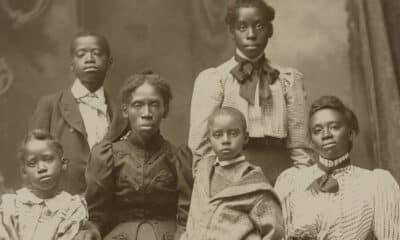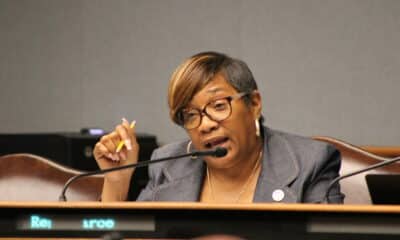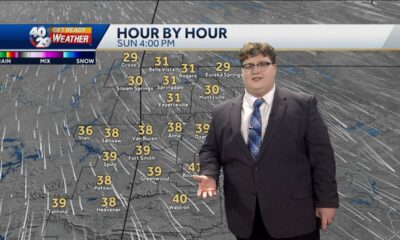Mississippi Today
Some imprisoned in Mississippi remain jailed long after parole eligibility

Transformation. Redemption. Forgiveness. Remorse.
A group of women who have served decades in Mississippi prisons use those words to describe how they have changed during incarceration and why the Parole Board should see that as evidence they can be released.
But “disheartening” is another word. They use it to describe the cycle of seeking parole. The Parole Board holds a hearing, it rejects their petitions and they have to wait years for another opportunity.
“I’ve taken accountability for my actions, sought to make reparations by living a life devoted to giving to others,” said Evelyn Smith, in a recording of her story in a campaign advocating for the release of her and four other women.
“Statistically and realistically, I pose no threat to society,” said the 80-year-old, who was most recently denied parole in 2022 and whose next hearing is in 2027. “I often ponder what is being accomplished by my continued incarceration.”
Smith is one of the Mississippi Five – women convicted of murder and sentenced to life with the possibility of parole that has never come. Collectively, they have been incarcerated for over 175 years and denied parole nearly 50 times.
The others are Loretta Pierre and Lisa Crevitt, 59; Linda Ross, 61 and Anita Krecic, 65.
Parole denials, which include setoffs between hearings and for the duration of a person’s sentence, account for over a third of all parole outcomes, according to a Mississippi Today analysis of parole data between 2013 and 2023.
Within the 10-year period, the highest number of setoffs was about 4,100 in 2016. Between 2017 and 2023, there have been roughly 2,000 setoffs each year.

Belk told Mississippi Today the board looks for evidence of rehabilitation during parole hearings, but it is also exercising more scrutiny in processes and preparing people for release in a meaningful way, contributing to the parole grant’s decrease.
Between 2013 and 2021, the average setoff between parole hearings was seven months, and in 2022, that increased to nearly 15 months. Belk has said the board has been using more two- and five-year setoff periods.
In a decade, the longest setoff handed down was for 10 years in 2021.
Belk said the longest setoff decided during his time on the board was eight years for Krecic, who has been eligible for parole since 1997 and has been denied 10 times. She was convicted of murder because she was with her boyfriend who fatally shot a state trooper on the Gulf Coast. He has since been executed.
Among those who received a five-year setoff was Smith, who has been incarcerated for over 30 years. Belk had told Mississippi Today’s Jerry Mitchell she was “unparole-able” because she didn’t understand the heinousness of her crime – the stabbing death of a Brookhaven woman and the transport of her body out of state.
In a recorded interview through the Free the Five campaign, Smith said she took on jobs, mentored younger women, kept a nearly spotless institutional record on her path to become “a person worthy of (a second chance)” and redeemable in the eyes of the parole board.
‘When is it enough?’
Pauline Rogers, co-founder of Jackson nonprofit Reaching and Educating for Community Hope Foundation, advocates for efforts to help people released from prison and reduce recidivism.
She’s seen the Mississippi Five and other incarcerated people take steps to change and demonstrate they are ready for release and have plans to keep them from returning to prison, only for them to be denied. At a certain point, Rogers said there is nothing more they can do to rehabilitate.

“If you perpetually punish them for something … How long do you punish them?” she asked. “When is it enough?”
Belk told Mississippi Today the board looks for evidence of rehabilitation during parole hearings, but it is also exercising more scrutiny in processes and preparing people for release in a meaningful way, contributing to the parole grant’s decrease.
It found what it saw as evidence when it released ouble murderer James Williams III, amid pushback from the family of his victims, lawmakers and members of law enforcement.
In prison, Williams earned a GED and a bachelor’s in Christian ministry and completed other educational rehabilitation programs, which signaled to the board that he was ready for release. After a DUI arrest months after his release, the board revoked his parole and sent him back to prison, where he remains.
Homicide remains the most common primary conviction for those denied parole – nearly 6% of all denial outcomes, according to MDOC data.
The chance for parole release for anyone, regardless of charges, has narrowed as the board’s grant rate has declined. Within a year of a new chairman, Jeffery Belk, and members joining the board, the parole grant fell from around two-thirds before 2021 to about a third in 2022.
Since last year, the parole grant rate has returned to above 50%. Since 2022, the board has paroled over 6,000 people.
Rogers sees issues with how parole is handled in Mississippi, including how the state doesn’t seem to give people a constitutional right to parole – leaving power in the hands of the board, including how to make decisions.
“The Parole Board has become judge, jury and executioner,” she said.
Seeming to support Rogers’ point, Julia Norman, the newest member of the board, said during her February 2023 Senate confirmation hearing that if someone was convicted of a violent crime and received a sentence shorter than the board thinks the person should have received, the board might deny release so the person can “finish that sentence off.”
Those convicted after 2014 are supposed to be reviewed for parole if they are not released at their initial parole date, which would be a one-year setoff, according to state law. Those convicted before that can be set off for longer than a year.
Belk said setoffs aren’t a definitive “no” because people have been paroled after trying multiple times to be released.
Of women with life sentences granted parole between 1989 and 2022, Barbara Wilson was denied parole 12 times before her release in 2022 after 37 years, according to records compiled by parole advocate Mitzi Magleby.
‘No chance of being paroled’
To make sure someone is ready for parole, Belk said the board might vote for a setoff to give the person time to complete a GED or a program like alcohol and drug treatment, which both have limited spaces in any given prison.
He and Steve Pickett, the former Parole Board chairman from 2013 to 2021, said when the board has felt unsure about whether someone was prepared for release, they ordered a setoff to see how the person would react.
Sometimes the person comes back before the board and shows improvement. Others don’t handle the rejection well and act out, sometimes landing them with a rules violation report, which can count against them in future parole hearings, Belk said.
In the past, Belk said there were people in prison for violent offenses with continuously bad behavior in prison who were receiving six-month setoffs, which he doesn’t see as a sign that the person can follow rules if released.
He said it was difficult for the board to continue to have to see those “who had no chance of being paroled” and to see victims and families relive and retell how the crime affected their lives each time the person had a parole hearing.
So the board decided to extend its setoff periods to two to five years for those with violent offenses to see if the extra time would help and to provide some relief for victims and families, Belk said.
He said this contributed to the parole rate’s decrease.
Beverly Warnock is executive director of Parents of Murdered Children, a national group based in Ohio that advocates for parents and other survivors, including in parole hearings.
Since 1990, the organization has worked with families to oppose parole of thousands of people convicted of murder across the country through its Parole Block Program. Through circulating petitions, the organization has helped keep more than 1,850 people in prison for a longer sentence after they became eligible for parole, Warnock said.
She said she believes the petitions send a message to the parole boards and show them that people have safety concerns if someone is released.
“It gave (families) the strong feeling of relief that the murderer would not get out,” Warnock said. “… They feel like they’re doing justice for their loved ones.”
To date no petitions have come from Missisisppi, she said, but that may because the organization doesn’t have a presence in the state. The nearest chapter is in Alabama.
Study and Struggle

Members of the Mississippi Five have participated in a political educational program hosted by Study and Struggle, a collaborative that focuses on prison abolition.
The campaign is using art to share the women’s stories and having conversations about parole and decarceration.
A collective of artists working with Study and Struggle turned oral history interviews with the women into zines that blend text, photos and drawings. The collaboration also included the Mississippi Five themselves, who provided feedback.
Jaime Dear, a Chicago area-based artist who worked on the zine about Krecic and helped design the others, said art is an effective way to communicate and a way to connect.
“(The zines) are for everyone to read,” Dear said. “The five should have their stories illustrated lovingly.”
Corey Devon Arthur, an artist and writer incarcerated in New York, created the color group photo of the women at the top of the Study and Struggle website that hosts information about the campaign and parole. An artist named Phan drew portraits for each of the Mississippi Five.
Loretta Pierre, who has been denied parole 14 times, was 20 years old and pregnant with her only child when she was charged with the murder of her ex-boyfriend’s new girlfriend.
She is now a grandmother to three children she has not met in person, Pierre said in her oral history interview with Study and Struggle.
Linda Ross, 61, has had seven parole denials. She pleaded guilty and was convicted for the murder of a man in Pike County, the McComb Enterprise Journal reported.
In her oral history interview, Ross said she was misdiagnosed at some point as mentally disabled and psychotic, but said she didn’t accept the evaluation as final and has overcome many challenges since.
During incarceration, she has earned a GED and is enrolled at Mississippi Valley State University through a prison education partnership.
She said she looks forward to returning home to be with her elderly mother and live out her senior years.
“I believe I have not only transformed my mind but have risen above resentments by using this opportunity to choose forgiveness,” Ross said.
This article first appeared on Mississippi Today and is republished here under a Creative Commons license.![]()
Mississippi Today
On this day in 1898

Feb. 22, 1898

Frazier Baker, the first Black postmaster of the small town of Lake City, South Carolina, and his baby daughter, Julia, were killed, and his wife and three other daughters were injured when a lynch mob attacked.
When President William McKinley appointed Baker the previous year, local whites began to attack Baker’s abilities. Postal inspectors determined the accusations were unfounded, but that didn’t halt those determined to destroy him.
Hundreds of whites set fire to the post office, where the Bakers lived, and reportedly fired up to 100 bullets into their home. Outraged citizens in town wrote a resolution describing the attack and 25 years of “lawlessness” and “bloody butchery” in the area.
Crusading journalist Ida B. Wells wrote the White House about the attack, noting that the family was now in the Black hospital in Charleston “and when they recover sufficiently to be discharged, they) have no dollar with which to buy food, shelter or raiment.
McKinley ordered an investigation that led to charges against 13 men, but no one was ever convicted. The family left South Carolina for Boston, and later that year, the first nationwide civil rights organization in the U.S., the National Afro-American Council, was formed.
In 2019, the Lake City post office was renamed to honor Frazier Baker.
“We, as a family, are glad that the recognition of this painful event finally happened,” his great-niece, Dr. Fostenia Baker said. “It’s long overdue.”
This article first appeared on Mississippi Today and is republished here under a Creative Commons license.![]()
Mississippi Today
Memorial Health System takes over Biloxi hospital, what will change?

by Justin Glowacki with contributions from Rasheed Ambrose, Javion Henry, McKenna Klamm, Matt Martin and Aidan Tarrant
BILOXI – On Feb. 1, Memorial Health System officially took over Merit Health Biloxi, solidifying its position as the dominant healthcare provider in the region. According to Fitch Ratings, Memorial now controls more than 85% of the local health care market.
This isn’t Memorial’s first hospital acquisition. In 2019, it took over Stone County Hospital and expanded services. Memorial considers that transition a success and expects similar results in Biloxi.
However, health care experts caution that when one provider dominates a market, it can lead to higher prices and fewer options for patients.
Expanding specialty care and services

One of the biggest benefits of the acquisition, according to Kristian Spear, the new administrator of Memorial Hospital Biloxi, will be access to Memorial’s referral network.
By joining Memorial’s network, Biloxi patients will have access to more services, over 40 specialties and over 100 clinics.
“Everything that you can get at Gulfport, you will have access to here through the referral system,” Spear said.
One of the first improvements will be the reopening of the Radiation Oncology Clinic at Cedar Lake, which previously shut down due to “availability shortages,” though hospital administration did not expand on what that entailed.
“In the next few months, the community will see a difference,” Spear said. “We’re going to bring resources here that they haven’t had.”
Beyond specialty care, Memorial is also expanding hospital services and increasing capacity. Angela Benda, director of quality and performance improvement at Memorial Hospital Biloxi, said the hospital is focused on growth.
“We’re a 153-bed hospital, and we average a census of right now about 30 to 40 a day. It’s not that much, and so, the plan is just to grow and give more services,” Benda said. “So, we’re going to expand on the fifth floor, open up more beds, more admissions, more surgeries, more provider presence, especially around the specialties like cardiology and OB-GYN and just a few others like that.”
For patient Kenneth Pritchett, a Biloxi resident for over 30 years, those changes couldn’t come soon enough.
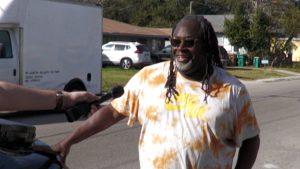
Pritchett, who was diagnosed with congestive heart failure, received treatment at Merit Health Biloxi. He currently sees a cardiologist in Cedar Lake, a 15-minute drive on the interstate. He says having a cardiologist in Biloxi would make a difference.
“Yes, it’d be very helpful if it was closer,” Pritchett said. “That’d be right across the track instead of going on the interstate.”
Beyond specialty services and expanded capacity, Memorial is upgrading medical equipment and renovating the hospital to improve both function and appearance. As far as a timeline for these changes, Memorial said, “We are taking time to assess the needs and will make adjustments that make sense for patient care and employee workflow as time and budget allow.”
Unanswered questions: insurance and staffing
As Memorial Health System takes over Merit Health Biloxi, two major questions remain:
- Will patients still be covered under the same insurance plans?
- Will current hospital staff keep their jobs?
Insurance Concerns
Memorial has not finalized agreements with all insurance providers and has not provided a timeline for when those agreements will be in place.
In a statement, the hospital said:
“Memorial recommends that patients contact their insurance provider to get their specific coverage questions answered. However, patients should always seek to get the care they need, and Memorial will work through the financial process with the payers and the patients afterward.”
We asked Memorial Health System how the insurance agreements were handled after it acquired Stone County Hospital. They said they had “no additional input.”
What about hospital staff?
According to Spear, Merit Health Biloxi had around 500 employees.
“A lot of the employees here have worked here for many, many years. They’re very loyal. I want to continue that, and I want them to come to me when they have any concerns, questions, and I want to work with this team together,” Spear said.
She explained that there will be a 90-day transitional period where all employees are integrated into Memorial Health System’s software.
“Employees are not going to notice much of a difference. They’re still going to come to work. They’re going to do their day-to-day job. Over the next few months, we will probably do some transitioning of their computer system. But that’s not going to be right away.”
The transition to new ownership also means Memorial will evaluate how the hospital is operated and determine if changes need to be made.
“As we get it and assess the different workflows and the different policies, there will be some changes to that over time. Just it’s going to take time to get in here and figure that out.”
During this 90-day period, Erin Rosetti, Communications Manager at Memorial Health System said, “Biloxi employees in good standing will transition to Memorial at the same pay rate and equivalent job title.”
Kent Nicaud, President and CEO of Memorial Health System, said in a statement that the hospital is committed to “supporting our staff and ensuring they are aligned with the long-term vision of our health system.”
What research says about hospital consolidations
While Memorial is promising improvements, larger trends in hospital mergers raise important questions.
Research published by the Rand Corporation, a nonprofit, nonpartisan research organization, found that research into hospital consolidations reported increased prices anywhere from 3.9% to 65%, even among nonprofit hospitals.
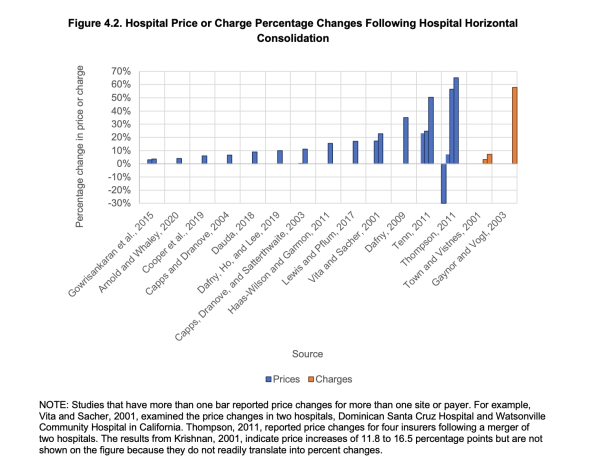
The impact on patient care is mixed. Some studies suggest merging hospitals can streamline services and improve efficiency. Others indicate mergers reduce competition, which can drive up costs without necessarily improving care.
When asked about potential changes to the cost of care, hospital leaders declined to comment until after negations with insurance companies are finalized, but did clarify Memorial’s “prices are set.”
“We have a proven record of being able to go into institutions and transform them,” said Angie Juzang, Vice President of Marketing and Community Relations at Memorial Health System.
When Memorial acquired Stone County Hospital, it expanded the emergency room to provide 24/7 emergency room coverage and renovated the interior.
When asked whether prices increased after the Stone County acquisition, Memorial responded:
“Our presence has expanded access to health care for everyone in Stone County and the surrounding communities. We are providing quality healthcare, regardless of a patient’s ability to pay.”
The response did not directly address whether prices went up — leaving the question unanswered.
The bigger picture: Hospital consolidations on the rise
According to health care consulting firm Kaufman Hall, hospital mergers and acquisitions are returning to pre-pandemic levels and are expected to increase through 2025.
Hospitals are seeking stronger financial partnerships to help expand services and remain stable in an uncertain health care market.
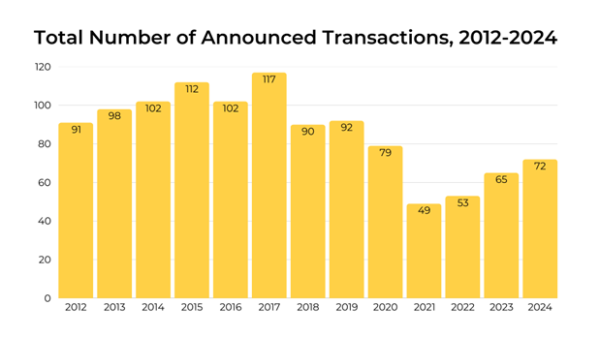
Source: Kaufman Hall M&A Review
Proponents of hospital consolidations argue mergers help hospitals operate more efficiently by:
- Sharing resources.
- Reducing overhead costs.
- Negotiating better supply pricing.
However, opponents warn few competitors in a market can:
- Reduce incentives to lower prices.
- Slow wage increases for hospital staff.
- Lessen the pressure to improve services.
Leemore Dafny, PhD, a professor at Harvard and former deputy director for health care and antitrust at the Federal Trade Commission’s Bureau of Economics, has studied hospital consolidations extensively.
In testimony before Congress, she warned: “When rivals merge, prices increase, and there’s scant evidence of improvements in the quality of care that patients receive. There is also a fair amount of evidence that quality of care decreases.”
Meanwhile, an American Hospital Association analysis found consolidations lead to a 3.3% reduction in annual operating expenses and a 3.7% reduction in revenue per patient.
This article first appeared on Mississippi Today and is republished here under a Creative Commons license.![]()
Mississippi Today
Adopted people face barriers obtaining birth certificates. Some lawmakers point to murky opposition from judges

When Judi Cox was 18, she began searching for her biological mother. Two weeks later she discovered her mother had already died.
Cox, 41, was born in Gulfport. Her mother was 15 and her father didn’t know he had a child. He would discover his daughter’s existence only when, as an adult, she took an ancestry test and matched with his niece.
It was this opaque family history, its details coming to light through a convergence of tragedy and happenstance, that led Cox to seek stronger legal protections for adopted people in Mississippi. Ensuring adopted people have access to their birth certificates has been a central pillar of her advocacy on behalf of adoptees. But legislative proposals to advance such protections have died for years, including this year.
Cox said the failure is an example of discrimination against adopted people in Mississippi — where adoption has been championed as a reprieve for mothers forced into giving birth as a result of the state’s abortion ban.
“A lot of people think it’s about search and reunion, and it’s not. It’s about having equal rights. I mean, everybody else has their birth certificate,” Cox said. “Why should we be denied ours?”
Mississippi lawmakers who have pushed unsuccessfully for legislation to guarantee adoptees access to their birth certificate have said, in private emails to Cox and interviews with Mississippi Today, that opposition comes from judges.
“There are a few judges that oppose the bill from what I’ve heard,” wrote Republican Sen. Angela Hill in a 2023 email.
Hill was recounting opposition to a bill that died during the 2023 legislative session, but a similar measure in 2025 met the same fate. In an interview this month, Hill said she believed the political opposition to the legislation could be bound up with personal interest.
“Somebody in a high place doesn’t want an adoption unsealed,” Hill said. “I don’t know who we’re protecting from somebody finding their birth parents,” Hill said. “But it leads you to believe some people have a very strong interest in keeping adoption records sealed. Unless it’s personal, I don’t understand it.”
In another 2023 email to Cox reviewed by Mississippi Today, Republican Rep. Lee Yancey wrote that some were concerned the bill “might be a deterrent to adoption if their identities were disclosed.”
The 2023 legislative session was the first time a proposal to guarantee adoptees access to their birth certificates was introduced under the state’s new legal landscape surrounding abortion.
In 2018, Mississippi enacted a law that banned most abortions after 15 weeks. The state’s only abortion clinic challenged the law, and that became the case that the U.S. Supreme Court used in 2022 to overturn Roe v. Wade, its landmark 1973 ruling that established a nationwide right to abortion.
Roe v. Wade had rested in part on a woman’s right to privacy, a legal framework Mississippi’s Solicitor General successfully undermined in Dobbs v. Jackson Women’s Health Organization. Before that ruling, anti-abortion advocates had feared allowing adoptees to obtain their birth certificates could push women toward abortion rather than adoption.
Abortion would look like a better option for parents who feared future contact or disclosure of their identities, the argument went. With legal access to abortion a thing of the past in Mississippi, Cox said she sees a contradiction.
“Mississippi does not recognize privacy in that matter, as far as abortions and all that. So if you don’t acknowledge it in an abortion setting, how can you do it in an adoption setting?” Cox said. “You can’t pick and choose whether you’re going to protect my privacy.”
Opponents to legislation easing access to birth certificates for adoptees have also argued that such proposals would unfairly override previous affidavits filed by birth parents requesting privacy.
The 2025 bill, proposed by Republican Rep. Billy Calvert, would direct the state Bureau of Vital Records to issue adoptees aged 21 and older a copy of their original birth certificate.
The bill would also have required the Bureau to prepare a form parents could use to indicate their preferences regarding contact from an adoptee. That provision, along with existing laws that guard against stalking, would give adoptees access to their birth certificate while protecting parents who don’t wish to be contacted, Cox said.
In 2021, Cox tried to get a copy of her birth certificate. She asked Lauderdale County Chancery Judge Charlie Smith, who is now retired, to unseal her adoption records. The Judge refused because Cox had already learned the identity of her biological parents, emails show.
“With the information that you already have, Judge Smith sees no reason to grant the request to open the sealed adoption records at this time,” wrote Tawanna Wright, administrator for the 12th District Chancery Court in Meridian. “If you would like to formally file a motion and request a hearing, you are certainly welcome to do so.”
In her case and others, judges often rely on a subjective definition of what constitutes a “good cause” for unsealing records, Cox said. Going through the current legal process for unsealing records can be costly, and adoptees can’t always control when and how they learn the identity of their biological parents, Cox added.
After Cox’s biological mother died, her biological uncle was going through her things and came across the phone number for Cox’s adoptive parents. He called them.
“My adoptive mom then called to tell me the news — just hours after learning I was expecting my first child,” Cox said.
This article first appeared on Mississippi Today and is republished here under a Creative Commons license.![]()
-

 News from the South - Louisiana News Feed2 days ago
News from the South - Louisiana News Feed2 days agoJeff Landry’s budget includes cuts to Louisiana’s domestic violence shelter funding
-

 News from the South - North Carolina News Feed6 days ago
News from the South - North Carolina News Feed6 days agoModest drops in some North Carolina prices under Trump | North Carolina
-

 News from the South - Texas News Feed7 days ago
News from the South - Texas News Feed7 days agoA developer bought up 70 properties on a historically Black street. The community doesn't know what's next
-

 News from the South - Arkansas News Feed6 days ago
News from the South - Arkansas News Feed6 days agoTiming out the incoming winter weather
-

 News from the South - Arkansas News Feed7 days ago
News from the South - Arkansas News Feed7 days agoFrigid Sunday conditions in Northwest Arkansas
-

 News from the South - Kentucky News Feed6 days ago
News from the South - Kentucky News Feed6 days agoEight die in flooding across Kentucky as rescues continue, governor warns of ‘wild weather week’
-

 News from the South - Oklahoma News Feed4 days ago
News from the South - Oklahoma News Feed4 days agoRemains of Aubrey Dameron found, family gathers in her honor
-

 News from the South - South Carolina News Feed5 days ago
News from the South - South Carolina News Feed5 days agoSC Flu cases on the rise: Prisma Health Doctors speak out on how to spot symptoms, get treatment







